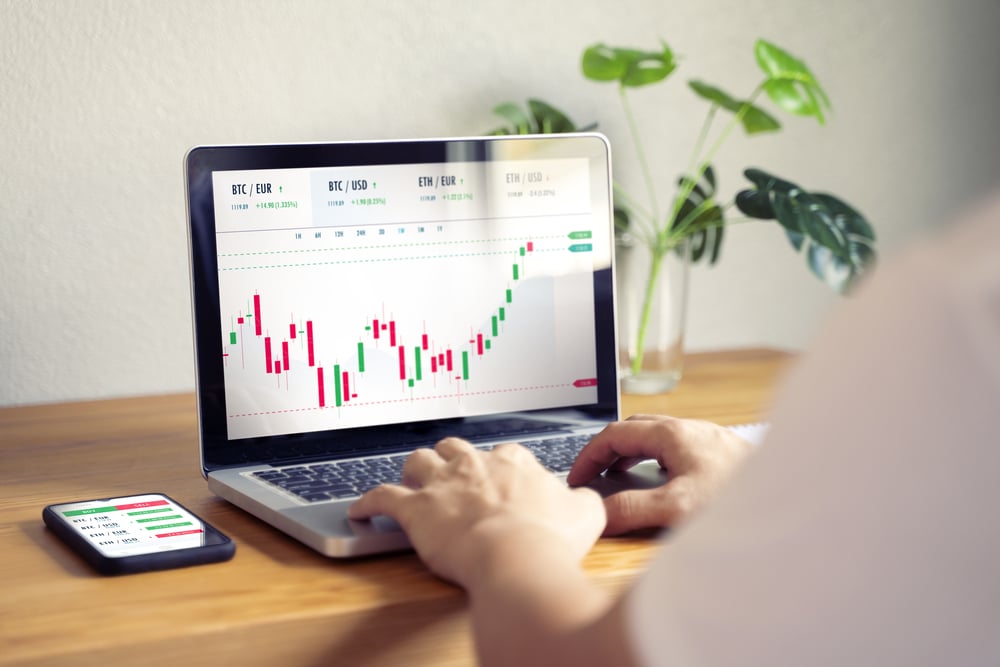
TradingSim: Is It Good a Trading Simulator?
TradingSim is a premier paper trading platform tailor-made by traders, for traders, offering a seamless experience for honing day trading skills. With accessibility around the clock and a user-friendly interface, it’s an ideal tool for traders to refine strategies at their own pace.
With an impressive array of functionalities, TradingSim stands out for its simplicity and depth. Boasting over 60 drawing tools and more than 50 indicators, it offers extensive customization options to suit individual trading styles.
Furthermore, it provides access to two years of historical data, including tick, level 1, time, and sales data, all accessible through a browser without requiring any downloads.
One notable feature is the ability to manipulate trading simulations, akin to controlling a video. Users can pause, play, or fast-forward trades, allowing real-time analysis or expedited results.
Moreover, the platform supports multiple chart views, facilitating comparisons across different time frames or against broader market movements seamlessly and without glitches.
Its Market Movers feature enables traders to identify stocks with significant movements, aiding in timely decision-making.
What’s important, its 24/7/365 access ensures flexibility for users to practice trading even when traditional markets are closed, accommodating diverse schedules and preferences.
The platform also offers practical features such as customizable watch lists linked to charts, zoom functionalities, and the ability to manage multiple positions and time frames effortlessly. Additionally, users can benefit from the insights and strategies shared in the TradingSim blog, enriching their trading knowledge and skills.
What is a paper trade?
A paper trade is a practice where individuals simulate buying and selling securities without actually executing real trades in the market. Instead, they use simulated accounts or platforms that mimic the functionality of real trading platforms to practice investing strategies, test new trading ideas, or simply gain experience without risking real money.
Paper trading serves several purposes and can be utilized by a wide range of individuals, from novice investors to seasoned traders, as well as institutional investors and professionals. Here are some key aspects of paper trading:
Learning and education: For beginners, paper trading offers a risk-free environment to learn about the financial markets, investment instruments, and trading strategies. It allows individuals to understand how the market works, how to place trades, and how different factors affect asset prices, all without the fear of losing money.

Strategy development: Traders often use paper trading to test new trading strategies or refine existing ones. They can experiment with different approaches, such as technical analysis, fundamental analysis, or various trading indicators, to see how they perform in different market conditions.
By observing the outcomes of simulated trades, traders can assess the effectiveness of their strategies and make adjustments accordingly.
Risk management: Managing risk is a crucial aspect of successful trading. Paper trading provides an opportunity to practice risk management techniques, such as setting stop-loss orders, diversifying portfolios, and managing position sizes without the consequences of real financial losses.
Traders can learn how to protect their capital and minimize potential losses in various market scenarios.
Market simulation: Paper trading platforms often simulate real market conditions, including price movements, order execution, and market volatility. This allows traders to experience trading in a realistic environment and prepare themselves for actual market conditions when they decide to start trading with real money.
Asset allocation
Investors can use paper trading to explore different asset classes, such as stocks, bonds, commodities, or cryptocurrencies, and experiment with different allocation strategies to build diversified portfolios.
They can observe how different assets perform over time and adjust their allocations based on their investment objectives and risk tolerance.
Behavioral finance
Paper trading can also help individuals understand their own behavior and emotions when it comes to trading. It provides insights into how emotions such as fear, greed, and overconfidence can influence decision-making and impact trading performance.
By practicing in a simulated environment, traders can develop discipline and emotional control, which are essential for long-term success in the markets.
Backtesting

Traders can use historical data to backtest their trading strategies on paper trading platforms. By analyzing past market data and simulating trades based on historical patterns, traders can evaluate the performance of their strategies over different time periods and market conditions. This allows them to identify strengths and weaknesses in their strategies and make improvements before implementing them in real trading.
Overall, paper trading is a valuable tool for investors and traders at all levels of experience. Whether it’s learning the basics of investing, testing new strategies, or honing trading skills, paper trading provides a risk-free environment to gain valuable experience and improve trading performance in the financial markets.
Paper trading vs live trading
Paper trading and live trading are two distinct approaches to participating in financial markets, each with its own advantages and limitations. Here’s a comparison between the two:
Paper trading
Risk-free environment: Perhaps the most significant advantage of paper trading is that it allows individuals to practice trading strategies in a risk-free environment. Since no real money is involved, traders can experiment freely without the fear of incurring financial losses.
Learning and education: Paper trading is an excellent tool for beginners to learn about the markets, test their understanding of trading concepts, and gain practical experience without risking capital.
What’s important: It provides an opportunity to understand how different factors impact asset prices and to familiarize oneself with the mechanics of trading platforms.
Strategy development: Traders can use paper trading to develop and refine trading strategies without risking real money. They can experiment with various approaches, analyze the outcomes of simulated trades, and make adjustments as needed to improve their strategies.
Emotional control: Since paper trading doesn’t involve real money, traders can practice maintaining emotional control and discipline in decision-making. It allows individuals to experience market fluctuations without the psychological pressure associated with real financial losses.
Live trading

Live trading involves real money, which means traders can experience actual profits or losses based on their trading decisions. This real-world feedback is crucial for assessing the effectiveness of trading strategies and understanding the true impact of market conditions.
Emotional challenges: Unlike paper trading, live trading involves real emotions and psychological challenges. Traders may experience fear, greed, and anxiety when real money is on the line, which can impact decision-making and trading performance.
Market liquidity and slippage: In live trading, traders face market liquidity and slippage issues, which may not be present in paper trading. Slippage occurs when the execution price of a trade differs from the expected price, particularly in fast-moving markets or when trading large orders.
Broker fees and commissions: Live trading typically incurs brokerage fees and commissions, which can impact overall trading performance. Traders need to consider transaction costs when evaluating the profitability of their trading strategies.
TradingSim alternatives
Tradingsim alternatives are Thinkorswim, offered by TD Ameritrade, is a comprehensive trading platform that includes a paper trading feature called PaperMoney. It provides access to real-time market data, advanced charting tools, and a wide range of trading instruments, allowing users to practice trading stocks, options, futures, and forex in a simulated environment.
As a reminder, TD Ameritrade belongs to the Charles Schwab Corporation, one of the largest brokerage firms in the United States, offering a wide range of financial services and investment products to individual investors, institutions, and advisors. Here are some key points about the company:
Brokerage services: Charles Schwab offers a comprehensive suite of brokerage services, including online trading of stocks, options, exchange-traded funds (ETFs), mutual funds, fixed-income securities, and more. It provides investors access to a wide range of investment products and tools to manage their portfolios.
Wealth management: In addition to brokerage services, Charles Schwab offers wealth management services, including financial planning, investment advisory, and portfolio management. The company’s financial advisors work with clients to develop personalized investment strategies tailored to their financial goals and risk tolerance.
Commitment to investor education: Charles Schwab is known for its commitment to investor education and empowerment. The company provides a wealth of educational resources, including articles, webinars, seminars, and tools designed to help investors make informed financial decisions.
Other options

TradeStation: TradeStation offers a simulator that allows users to practice trading stocks, options, futures, and forex using the TradeStation platform. Interestingly, its simulator provides access to historical market data, advanced analysis tools, and customizable trading strategies for users to test their ideas and improve their trading skills.
NinjaTrader: NinjaTrader is a trading platform popular among active traders and offers a simulation mode for users to practice trading without risking real capital. Its simulator provides real-time market data, advanced charting capabilities, and a wide range of trading tools for users to simulate trading stocks, futures, and forex.
TradingView: TradingView is a web-based platform known for its advanced charting features and social trading community. The paper trading feature on TradingView currently supports stocks, forex and futures markets.
Importantly, the platform provides access to real-time market data, technical analysis tools, and the ability to share trading ideas with other users.
Interactive Brokers: Interactive Brokers, a popular brokerage firm, offers a paper trading account. Users can test different trading strategies, analyze performance metrics, and gain familiarity with the platform’s features.
Webull: Webull is a commission-free brokerage platform that offers a paper trading feature for users to practice trading stocks. Traders can take advantage of more than 50 technical indicators and 12 charting tools.
The paper trading platform provides access to real-time market data, advanced charting tools, and trading simulator to help users hone their trading skills before trading with real money.
In summary, TradingSim provides a comprehensive and user-centric environment for traders to refine their craft. tradingsim offers a range of features designed to enhance the virtual trading experience and facilitate continuous improvement.
The post TradingSim: Is It Good a Trading Simulator? appeared first on FinanceBrokerage.
